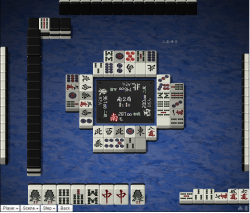Talk:Atozuke: Difference between revisions
No edit summary |
mNo edit summary |
||
| (One intermediate revision by one other user not shown) | |||
| Line 36: | Line 36: | ||
The state of atozuke is used to determine if you broke the rule of sakizuke in nashi-nashi mahjong. The [European Mahjong Association] has chosen to ignore this "detail" when conceiving their local ruleset, creating a unique nashi-ari experience. | The state of atozuke is used to determine if you broke the rule of sakizuke in nashi-nashi mahjong. The [European Mahjong Association] has chosen to ignore this "detail" when conceiving their local ruleset, creating a unique nashi-ari experience. | ||
== | == Kanzen Sakizuke == | ||
[[ | Just noting this term. [[User:KyuuSC|KyuuSC]] ([[User talk:KyuuSC|talk]]) 04:17, 17 April 2018 (UTC) | ||
[[ | |||
Latest revision as of 01:29, 28 February 2023
Testing a rewrite for atozuke:
Atozuke 「後付け」 is the state of a hand that is severely dependent on calls to complete the hand. This always implies the winning tile is dependent on calling, but previous calls can trigger the atozuke state as well.
Example
What atozuke is
The cases where a hand is caught in an atozuke position are:
- when a hand is waiting on a tile that will provide it its winning yaku, such as
- when a hand has opened up and is not dependent on the first call to score the yaku, such as
- calling for a group and then aiming to complete something with it, such as:
What atozuke is not
Cases that are not atozuke are when the hand contains a fully concealed yaku (yakuhai, sanshoku, ikkitsuukan), such as:
... or when the first call confirms the yaku, such as:
... or when the hand aims for an obvious hand condition, such as:
What circumstances ignore atozuke
- Self-picking (whether with menzen tsumo or not, as long as a yaku is normally present).
- Calling riichi (since riichi is always going to be present).
- The obvious yaku, including hon'itsu/chin'itsu, toitoi
- Ask about circumstancial yaku: rinshan kaihou, haitei, houtei. Some places ban the use of circumstancial yaku as to ignore atozuke. Chankan is generally viewed as not ever being a sufficient yaku.
Risk of furiten

Particularly, open yakuless hands run the risk of furiten. That is especially true if the above example draws a 9-pin during the course of the hand, when additional tile draws remain in the wall. In this case, a player cannot declare a win and must discard any tile in the hand. Upon doing so, the player become furiten and must work around it, by changing its hand composion with the remain tile draws or other player discards.
Impact of atozuke
The state of atozuke is used to determine if you broke the rule of sakizuke in nashi-nashi mahjong. The [European Mahjong Association] has chosen to ignore this "detail" when conceiving their local ruleset, creating a unique nashi-ari experience.
Kanzen Sakizuke
Just noting this term. KyuuSC (talk) 04:17, 17 April 2018 (UTC)